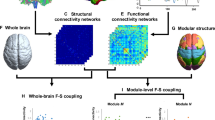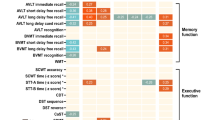Abstract
Mild cognitive impairment (MCI) is clinically characterized by memory loss and cognitive impairment closely associated with the hippocampal atrophy. Accumulating studies have confirmed the presence of neural signal changes within white matter (WM) in resting-state functional magnetic resonance imaging (fMRI). However, it remains unclear how abnormal hippocampus activity affects the WM regions in MCI. The current study employs 43 MCI, 71 very MCI (VMCI) and 87 age-, gender-, and education-matched healthy controls (HCs) from the public OASIS-3 dataset. Using the left and right hippocampus as seed points, we obtained the whole-brain functional connectivity (FC) maps for each subject. We then perform one-way ANOVA analysis to investigate the abnormal FC regions among HCs, VMCI, and MCI. We further performed probabilistic tracking to estimate whether the abnormal FC correspond to structural connectivity disruptions. Compared to HCs, MCI and VMCI groups exhibited reduced FC in the right middle temporal gyrus within gray matter, and right temporal pole, right inferior frontal gyrus within white matter. Specific dysconnectivity is shown in the cerebellum Crus II, left inferior temporal gyrus within gray matter, and right frontal gyrus within white matter. In addition, the fiber bundles connecting the left hippocampus and right temporal pole within white matter show abnormally increased mean diffusivity in MCI. The current study proposes a new functional imaging direction for exploring the mechanism of memory decline and pathophysiological mechanisms in different stages of Alzheimer’s disease.






Similar content being viewed by others
Data availability
The current study employed the public available dataset from the OASIS-3 dataset (https://central.xnat.org). The OASIS-3 is a compilation of MRI and PET imaging data collected from several studies conducted by the Knight AD Research Center at the University of Washington over the past 15 years. All subjects had provided informed consent before MRI or neurological assessment. In addition, clinical scale information for all patients has been obtained.
References
Aggleton JP (2012) Multiple anatomical systems embedded within the primate medial temporal lobe: implications for hippocampal function. Neurosci Biobehav Rev 36(7):1579–1596. https://doi.org/10.1016/j.neubiorev.2011.09.005
Arnold SE, Hyman BT, Van Hoesen GW (1994) Neuropathologic changesof the temporal pole in Alzheimer's disease and Pick's disease. Arch Nneurol. https://doi.org/10.1001/archneur.1994.00540140051014
Bartsch T, Wulff P (2015) The hippocampus in aging and disease: from plasticity to vulnerability. Neuroscience 309:1–16. https://doi.org/10.1016/j.neuroscience.2015.07.084
Bazinet V, Vos de Wael R, Hagmann P et al (2021) Multiscale communication in cortico-cortical networks. Neuroimage. https://doi.org/10.1016/j.neuroimage.2021.118546
Buckner RL, Wheeler ME (2001) The cognitive neuroscience of remembering. Nat Rev Neurosci 2(9):624–634. https://doi.org/10.1038/35090048
Callen DJ, Black SE, Caldwell CB (2002) Limbic system perfusion in Alzheimer’s disease measured by MRI-coregistered HMPAO SPET. Eur J Nucl Med Mol Imaging 29(7):899–906. https://doi.org/10.1007/s00259-002-0816-3
Clark KA, Nuechterlein KH, Asarnow RF et al (2011) Mean diffusivity and fractional anisotropy as indicators of disease and genetic liability to schizophrenia. J Psychiatr Res. https://doi.org/10.1016/j.jpsychires.2011.01.006
Convit A, De Asis J, De Leon MJ (2000) Atrophy of the medial occipitotemporal, inferior, and middle temporal gyri in non-demented elderly predict decline to Alzheimer’s disease. Neurobiol Aging 21(1):19–26. https://doi.org/10.1016/S0197-4580(99)00107-4
De Santi S, De Leon MJ, Rusinek H et al (2001) Hippocampal formation glucose metabolism and volume losses in MCI and AD. Neurobiol Aging. https://doi.org/10.1016/S0197-4580(01)00230-5
DeLisi LE, Szulc KU, Bertisch H et al (2006) Early detection of schizophrenia by diffusion weighted imaging. Psychiatry Res Neuroimag. https://doi.org/10.1016/j.pscychresns.2006.04.010
Ding Z, Huang Y, Bailey SK, Gao Y, Cutting LE, Rogers BP, Newton AT, Gore JC (2018) Detection of synchronous brain activity in white matter tracts at rest and under functional loading. Proc Natl Acad Sci USA 115(3):595–600. https://doi.org/10.1073/pnas.1711567115
Endel Tulving HJM (1998) Episodic and declarative memory: role of the hippocampus. Hippocampus
Fjell AM, Sneve MH, Grydeland H, Storsve AB, Amlien IK, Yendiki A, Walhovd KB (2017) Relationship between structural and functional connectivity change across the adult lifespan: a longitudinal investigation. Hum Brain Mapp 38(1):561–573. https://doi.org/10.1002/hbm.23403
Frisoni GB, Fox NC, Jack CR Jr, Scheltens P, Thompson PM (2010) The clinical use of structural MRI in Alzheimer disease. Nat Rev Neurol 6(2):67–77. https://doi.org/10.1038/nrneurol.2009.215
Gao Y, Sengupta A, Li M, Zu Z, Rogers BP, Anderson AW, Ding Z, Gore JC, Alzheimer’s Disease Neuroimaging I (2020) Functional connectivity of white matter as a biomarker of cognitive decline in Alzheimer’s disease. PLoS ONE 15(10):e0240513. https://doi.org/10.1371/journal.pone.0240513
Geroldi C, Laakso MP, DeCarli C (2000) Apolipoprotein E genotype and hippocampal asymmetry in Alzheimer’s disease a volumetric MRI study. J Neurol Neurosurg Psychiatry 68(1):93–96. https://doi.org/10.1136/jnnp.68.1.93
Holmes G (1908) A form of familial degeneration of the cerebellum. Brain 30(4):466–489. https://doi.org/10.1093/brain/30.4.466
Horn A, Ostwald D, Reisert M, Blankenburg F (2014) The structural-functional connectome and the default mode network of the human brain. Neuroimage. https://doi.org/10.1016/j.neuroimage.2013.09.069
Huang H, Ding M (2016) Linking functional connectivity and structural connectivity quantitatively: a comparison of methods. Brain Connect 6(2):99–108. https://doi.org/10.1089/brain.2015.0382
Irena Štepán-Buksakowska M, *w Nikoletta Szabo´, wz Daniel Horˇı´nek (2014) Cortical and subcortical atrophy in alzheimer disease parallel atrophy of thalamus and hippocampus. Alzheimer Dis Assoc Disord
Jacobs HIL, Hopkins DA, Mayrhofer HC, Bruner E, van Leeuwen FW, Raaijmakers W, Schmahmann JD (2018) The cerebellum in Alzheimer’s disease: evaluating its role in cognitive decline. Brain 141(1):37–47. https://doi.org/10.1093/brain/awx194
Ji GJ, Ren C, Li Y, Sun J, Liu T, Gao Y, Xue D, Shen L, Cheng W, Zhu C, Tian Y, Hu P, Chen X, Wang K (2019) Regional and network properties of white matter function in Parkinson’s disease. Hum Brain Mapp 40(4):1253–1263. https://doi.org/10.1002/hbm.24444
Jiang Y, Luo C, Li X, Li Y, Yang H, Li J, Chang X, Li H, Yang H, Wang J, Duan M, Yao D (2019a) White-matter functional networks changes in patients with schizophrenia. Neuroimage 190:172–181. https://doi.org/10.1016/j.neuroimage.2018.04.018
Jiang Y, Song L, Li X, Zhang Y, Chen Y, Jiang S, Hou C, Yao D, Wang X, Luo C (2019b) Dysfunctional white-matter networks in medicated and unmedicated benign epilepsy with centrotemporal spikes. Hum Brain Mapp 40(10):3113–3124. https://doi.org/10.1002/hbm.24584
John C. Morris M, * Sandra Weintraub, w Helena C (2006) The Uniform Data Set (UDS): clinical and cognitive variables and descriptive data from alzheimer disease centers
Köhler S, McIntosh AR, Moscovitch M (1998) Functional interactions between the medial temporal lobes and posterior neocortex related to episodic memory retrieval. Cereb Cortex 8(5):451–461. https://doi.org/10.1093/cercor/8.5.451
Liu X, Wang S, Zhang X, Wang Z, Tian X, He Y (2014) Abnormal amplitude of low-frequency fluctuations of intrinsic brain activity in Alzheimer’s disease. J Alzheimers Dis 40(2):387–397. https://doi.org/10.3233/JAD-131322
Lombardi G, Crescioli G, Cavedo E, Lucenteforte E, Casazza G, Bellatorre AG, Lista C, Costantino G, Frisoni G, Virgili G, Filippini G (2020) Structural magnetic resonance imaging for the early diagnosis of dementia due to Alzheimer’s disease in people with mild cognitive impairment. Cochrane Database Syst Rev 3:CD009628. https://doi.org/10.1002/14651858.CD009628.pub2
Maruszak A, Thuret S (2014) Why looking at the whole hippocampus is not enough-a critical role for anteroposterior axis, subfield and activation analyses to enhance predictive value of hippocampal changes for Alzheimer’s disease diagnosis. Front Cell Neurosci. https://doi.org/10.3389/fncel.2014.00095
Misra C, Fan Y, Davatzikos C (2009) Baseline and longitudinal patterns of brain atrophy in MCI patients, and their use in prediction of short-term conversion to AD: results from ADNI. Neuroimage. https://doi.org/10.1016/j.neuroimage.2008.10.031
Morris JC, Weintraub S, Chui HC (2006) The uniform data set (UDS): clinical and cognitive variables and descriptive data from alzheimer disease centers. Alzheimers Dis Assoc Disord 20(4):210–216. https://doi.org/10.1097/01.wad.0000213865.09806.92
Neugroschl J, Wang S (2011) Alzheimer’s disease: diagnosis and treatment across the spectrum of disease severity. Mt Sinai J Med 78(4):596–612. https://doi.org/10.1002/msj.20279
Patenaude B, Smith SM, Kennedy DN, Jenkinson M (2011) A Bayesian model of shape and appearance for subcortical brain segmentation. Neuroimage 56(3):907–922. https://doi.org/10.1016/j.neuroimage.2011.02.046
Peer M, Nitzan M, Bick AS, Levin N, Arzy S (2017) Evidence for Functional Networks within the Human Brain’s White Matter. J Neurosci 37(27):6394–6407. https://doi.org/10.1523/JNEUROSCI.3872-16.2017
Rektorova I (2014) Resting-state networks in Alzheimer’s disease and Parkinson’s disease. Neurodegener Dis 13(2–3):186–188. https://doi.org/10.1159/000354237
Rosales-Corral SA, Acuna-Castroviejo D, Coto-Montes A, Boga JA, Manchester LC, Fuentes-Broto L, Korkmaz A, Ma S, Tan DX, Reiter RJ (2012) Alzheimer’s disease: pathological mechanisms and the beneficial role of melatonin. J Pineal Res 52(2):167–202. https://doi.org/10.1111/j.1600-079X.2011.00937.x
Sampaio-Baptista C, Johansen-Berg H (2017) White matter plasticity in the adult brain. Neuron 96(6):1239–1251. https://doi.org/10.1016/j.neuron.2017.11.026
Schmahmann JD (2019) The cerebellum and cognition. Neurosci Lett 688:62–75. https://doi.org/10.1016/j.neulet.2018.07.005
Sporns O (2013) Structure and function of complex brain networks. Dialogues Clin Neurosci 15(3):247
Szabo CA, Xiong J, Lancaster JL (2001) Amygdalar and hippocampal volumetry in control participants: differences regarding handedness. Am J Neuroradiol 22(7):1342–1345. https://www.webofscience.com/wos/alldb/fullrecord/WOS:000170437200018
Tang F, Zhu D, Ma W, Yao Q, Li Q, Shi J (2021) Differences changes in cerebellar functional connectivity between mild cognitive impairment and Alzheimer’s disease: a seed-based approach. Front Neurol 12:987
Tombaugh TN, McIntyre NJ (1992) The mini-mental state examination: a comprehensive review. J Am Geriatr Soc 40(9):922–935. https://doi.org/10.1111/j.1532-5415.1992.tb01992.x
Tops M, Boksem MAS (2011) A potential role of the inferior frontal gyrus and anterior insula in cognitive control, brain rhythms, and event-related potentials. Front Psychol. https://doi.org/10.3389/fpsyg.2011.00330
Van Den Heuvel M, Mandl R, Luigjes J, Pol HH (2008) Microstructural organization of the cingulum tract and the level of default mode functional connectivity. J Neurosci. https://doi.org/10.1523/JNEUROSCI.2964-08.2008
Walhovd KB, Johansen-Berg H, Karadottir RT (2014) Unraveling the secrets of white matter–bridging the gap between cellular, animal and human imaging studies. Neuroscience 276:2–13. https://doi.org/10.1016/j.neuroscience.2014.06.058
Wang J, Yang Z, Zhang M, Shan Y, Rong D, Ma Q, Liu H, Wu X, Li K, Ding Z, Lu J (2019) Disrupted functional connectivity and activity in the white matter of the sensorimotor system in patients with pontine strokes. J Magn Reson Imaging 49(2):478–486. https://doi.org/10.1002/jmri.26214
Wang P, Meng C, Yuan R, Wang J, Yang H, Zhang T, Zaborszky L, Alvarez TL, Liao W, Luo C, Chen H, Biswal BB (2020a) The organization of the human corpus callosum estimated by intrinsic functional connectivity with white-matter functional networks. Cereb Cortex 30(5):3313–3324. https://doi.org/10.1093/cercor/bhz311
Wang P, Zhou B, Yao H, Xie S, Feng F, Zhang Z, Guo Y, An N, Zhou Y, Zhang X, Liu Y (2020b) Aberrant hippocampal functional connectivity is associated with fornix white matter integrity in Alzheimer’s disease and mild cognitive impairment. J Alzheimers Dis 75(4):1153–1168. https://doi.org/10.3233/JAD-200066
Wang P, Wang J, Tang Q, Alvarez TL, Wang Z, Kung YC, Lin CP, Chen H, Meng C, Biswal BB (2021a) Structural and functional connectivity mapping of the human corpus callosum organization with white-matter functional networks. Neuroimage 227:117642. https://doi.org/10.1016/j.neuroimage.2020.117642
Wang P, Wang J, Michael A et al (2021c) White matter functional connectivity in resting-state fMRI: robustness, reliability, and relationships to gray matter. Cereb Cortex. https://doi.org/10.1093/cercor/bhab181
Wang L, Zang Y, He Y (2005) Changes in hippocampal connectivity in the early stages of Alzheimer's disease: Evidence from resting state fMRI. Neuroimage 31(2):496–504. https://doi.org/10.1016/j.neuroimage.2005.12.033
Wang P, Wang Z, Wang J, Jiang Y, Zhang H, Li H, Biswal BB (2021b) Altered homotopic functional connectivity within white matter in the early stages of Alzheimer's disease. Front Neurosci
William Beecher Scoviille BM (1957) Loss of recent memory after bilateral hippocampal lesions. J Neurol Neurosurg Psychiat
Yamada H, Abe O, Shizukuishi T, Kikuta J, Shinozaki T, Dezawa K, Nagano A, Matsuda M, Haradome H, Imamura Y (2014) Efficacy of distortion correction on diffusion imaging: comparison of FSL eddy and eddy_correct using 30 and 60 directions diffusion encoding. PLoS ONE 9(11):e112411
Zhao J, Ding X, Du Y, Wang X, Men G (2019) Functional connectivity between white matter and gray matter based on fMRI for Alzheimer’s disease classification. Brain Behav 9(10):e01407. https://doi.org/10.1002/brb3.1407
Zhu H, Xu J, Li J, Peng H, Cai T, Li X, Wu S, Cao W, He S (2017) Decreased functional connectivity and disrupted neural network in the prefrontal cortex of affective disorders: a resting-state fNIRS study. J Affect Disord 221:132–144. https://doi.org/10.1016/j.jad.2017.06.024
Funding
This work was supported by the China MOST2030 Brain Project (Grant numbers: 2022ZD0208500) and the National Natural Science Foundation of China (Grant numbers: 61871420, 62171101).
Author information
Authors and Affiliations
Corresponding authors
Ethics declarations
Conflict of interest
The authors declare no conflict of interest.
Additional information
Publisher's Note
Springer Nature remains neutral with regard to jurisdictional claims in published maps and institutional affiliations.
Supplementary Information
Below is the link to the electronic supplementary material.
Rights and permissions
About this article
Cite this article
Jiang, Y., Wang, P., Wen, J. et al. Hippocampus-based static functional connectivity mapping within white matter in mild cognitive impairment. Brain Struct Funct 227, 2285–2297 (2022). https://doi.org/10.1007/s00429-022-02521-x
Received:
Accepted:
Published:
Issue Date:
DOI: https://doi.org/10.1007/s00429-022-02521-x




